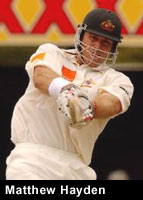Kiwis make a point in final session
Daniel Laidlaw
Leading into a Test series seen unfairly but inevitably as a warm-up prior
to the world title clash with South Africa, New Zealand’s chances of
seriously competing with Australia had been widely dismissed, firstly
because on paper they don’t match up to Australia’s powerful team and
secondly, because of injury concerns over several key players.
What had been ignored is that despite the injury worries New Zealand are a
well-organised and improving team who have a habit of playing their
trans-Tasman rivals very tough. No matter what the statistics say, a
series
against Australia is the most important contest for New Zealand and the
motivation of upending their invariably more highly fancied rivals is such
that records become fairly inconsequential.
 And, for the first Test, New Zealand had its first-choice XI available,
arguably the strongest team they have fielded against Australia for
sixteen years. They received nothing but pre-series respect from the Australian
camp, although given the Australians had similar regard for England prior
the Ashes, that had to be taken with a grain of salt.
And, for the first Test, New Zealand had its first-choice XI available,
arguably the strongest team they have fielded against Australia for
sixteen years. They received nothing but pre-series respect from the Australian
camp, although given the Australians had similar regard for England prior
the Ashes, that had to be taken with a grain of salt.
In Cairns, Nash, O’Connor and Vettori, New Zealand went into the match
with
a respectable attack. Given the weakness of their top order – openers
Richardson and Bell haven’t made any runs – and the ferocity of
Australia’s
bowling, winning the toss and bowling first was always the ideal option
for
the Kiwis. Despite a Gabba pitch not as typically well grassed as usual,
that’s exactly what happened.
Kiwi skipper Stephen Fleming knew that having bowled first, it was
essential
to capture at least two Australian wickets in the first session. The
importance of wickets in the first hour thus made it doubly disappointing
when, in the first over, Cairns trapped Langer plumb lbw with no score on
the board, only for umpire Harper to say no.
Beaten and hit on the roll of the back pad, it was impossible to see how
the ball was missing middle stump, yet New Zealand were denied. Langer’s large
slice of fortune was to make his tenure only marginally better, as he
scratched around and grimly clung to his wicket while struggling to hit
the ball off the square.
Langer’s edginess was in stark contrast to opening partner Matt Hayden,
who hit the ball well in a confident start. New Zealand opted to open with
Nash alongside Cairns rather than swing bowler Shayne O’Connor, but with Nash
spraying the ball too wide, O’Connor was soon introduced.
Cairns was still the only bowler to concern the openers, as O’Connor
switched between delivering half-volleys or pitching short enough to be
pulled. Having safely negotiated the first hour, Hayden took toll of O’
Connor’s inconsistent offerings, twice driving him thunderously down the
ground then pulling him away for three consecutive fours that took him to
an
explosive half-century from 54 balls (9 x 4). That Australia had only
scored
62 was a measure of his predominance, as Langer by contrast barely clung
on.
 Having been pounded for 28 off four overs, O’Connor was relieved by Daniel
Vettori as Fleming sought to discover whether there was any early turn
available. Australia’s batsmen apparently have a policy of attempting to
destroy spinners as soon as they enter the attack, to prevent them from
settling into any rhythm. It was attempted against Harbhajan Singh, Phil
Tufnell and now Vettori, as Hayden leapt down the track to his first ball
and lofted it over mid on for six in taking 14 from Vettori’s first over.
Having been pounded for 28 off four overs, O’Connor was relieved by Daniel
Vettori as Fleming sought to discover whether there was any early turn
available. Australia’s batsmen apparently have a policy of attempting to
destroy spinners as soon as they enter the attack, to prevent them from
settling into any rhythm. It was attempted against Harbhajan Singh, Phil
Tufnell and now Vettori, as Hayden leapt down the track to his first ball
and lofted it over mid on for six in taking 14 from Vettori’s first over.
By losing no wickets in reaching 103 at lunch, Australia had ensured New
Zealand lost any advantage by bowling first and were set up for a score of
at least 450 against an underdone attack. Hayden had 71 and Langer, whose
first well-timed shot took 90 minutes, a battling 26.
O’Connor bowled a more disciplined line and length post-lunch, helping to
restrict Australia to 31 runs in the third hour without threatening to
break
through. Hayden remained confident and forceful while Langer was cautious,
playing late and allowing the ball to come to him. To be critical, you
could
say New Zealand bowled too straight, as Langer was frequently allowed to
turn the ball off his legs for singles.
At 0/125, New Zealand had its second genuine case for a wicket when
Hayden,
not allowed to play with quite so much freedom, mishit a drive to cover
off
O’Connor. Craig McMillan leapt to his left to snare the ball in his left
hand for what would have been a spectacular catch but spilt it as he hit
the
ground, giving Hayden a life at 83.
Langer got to his fifty when Vettori came back as both batsmen settled in
to
pick off a weakening attack in the second hour of the session. With the
tempo lifting again, Hayden reached his fourth Test hundred (138 balls, 15
x
4, 1 x 6) by lofting Vettori over mid off, a joyous moment for the
Queenslander on his home ground. It was also just his second Test hundred
in
Australia.
Langer found his feet after passing 50, striking the ball with greater
confidence, while Hayden continued to pick the gaps and leave astutely,
frustrating Nash. At 199, the opening partnership broke the previous
first-wicket record for Australia against New Zealand, 198 by Mark Taylor
and Michael Slater in 1993/’94. After putting on 158 in their only other
innings together, Australia appears to have found an effective opening
combination. They enjoyed batting together, too, celebrating each
partnership milestone with a grin and a handshake.
Nathan Astle had been introduced prior to tea to fulfil a restrictive
role,
tying down one end by bowling to a packed off side field to try to
‘strangle
’ a wicket. He continued in that fashion after tea, supporting Cairns as
the
latter worked on bowling bouncers. Eventually it succeeded, as another
Cairns short ball over off stump had Hayden caught at deep mid-wicket off
a
top-edged hook for 136, breaking the partnership at 224.
What followed was completely unexpected and out of character. Having
established a dominance over the bowling, Australia threw it all away with
a
remarkable last session collapse of 6/39, owing as much to complacency and
lazy batting as Stephen Fleming’s clever strategy of employing Craig
McMillan.
Chris Cairns was the catalyst, though. After getting away with an
uncontrolled hook, Ricky Ponting played a strange half-hearted uppercut to
a short and rising ball outside off, succeeding only in sending it high for
Vettori to take the catch running back from gully.
After that double breakthrough Astle, still applying pressure at the other
end as he did throughout his 16 overs, got through a nervy Mark Waugh’s
defence as the batsman played across the line to fall plumb in front for a
duck.
Cairns, the heart of the Black Caps’ bowling, then seemingly had Langer
caught at gully before replays confirmed he had driven the ball straight
into the ground. With the new ball coming up, Fleming had little choice
but
to rest Cairns, bringing another part-timer in McMillan on in his place.
It
would prove an inspired move.
McMillan, whose stock ball is the bouncer, installed a leg gully and a
short
leg to bowl at Steve Waugh, as the Kiwis turned the screws. The tactic
paid
off as Waugh, continually pushed onto the back foot and unwilling to hook,
stayed back when McMillan pitched further up outside off, attempting to
force a leg-cutter off the back foot to be caught behind for 3. Enticed
into
error, Australia were 4/256.
The complacent batting continued as Damien Martyn, star batsman in the
Ashes, cut a wide and very short McMillan delivery straight to Vettori at
point. There was an element of planning that shouldn’t be understated, as
the field had changed to two gullies and a mid-wicket to account for
Martyn’
s strengths, but it was still reckless batting by an Australian batsman
with
perhaps a bit too much pride to simply grind it out against New Zealand’s
effective part-time bowling. Martyn made 4, and Australia were 5/260.
Langer - who meanwhile had reached his hundred, his second in as many Test
innings – then gave his innings away at 104 in another reckless piece of
batting, pulling an overjoyed McMillan straight to deep mid wicket. It
capped a collapse of 6/39 that saw Australia tumble from a
500-is-a-certainty score of 0/224 to 263/6. The cheeky and aggressive
McMillan, brought on primarily for a containing job, had 3/7 off 5 overs
when the second new ball was taken.
Ironically, Australia suffered no further loss against the second new ball
taken by Cairns and Nash, as Gilchrist and Warne set about consolidating
and
playing till stumps.
New Zealand’s best chance of further success came
after
McMillan was brought back, when Gilchrist top edged a streaky four and had
a
close lbw shout go in his favour.
After a bizarre series of scores that read 104, 136, 5, 0, 3 and 4,
Australia’s score of 294/6 should at least serve as a wake up call to
those prepared too dismiss New Zealand too lightly.
Scorecard: Australian 1st innings
More Columns
Mail Daniel Laidlaw